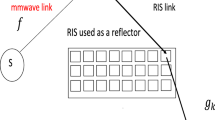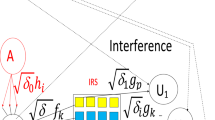Abstract
In this paper, we suggest the use of Intelligent Reflecting Surfaces (IRS) for Non Orthogonal Multiple Access (NOMA) using millimeter wave communications. The source sends a combination of K symbols dedicated to K users. The received signal at relay node R is affected with P interferers. The relay node detects the symbol of the weak user as it is transmitted with the largest power. Then, it uses Successive Interference Cancelation (SIC) to remove the contribution of the signal of the weak user to detect the symbol of the second weakest user. The rest of the detections are performed similarly until relay node detects all K symbols. The relay node sends a combination of the detected symbols. The transmitted signal by the relay node is reflected by different sets of IRS reflectors. The reflected signals reach the i-th user with the same phase. The phase shift of i-th IRS reflector depends on the phase of channel coefficient between relay and IRS as well as the phase of channel coefficient between IRS and user. The i-th strong user uses SIC to detect the symbols of \(K-i-1\) weak users to be able to detect its symbol. We optimize the fraction of powers allocated to NOMA users at the source and relay node to maximize the total throughput. The results are valid for Nakagami channels and any number of interferers at the relay and NOMA users. When there are two users, a total throughput of 3.5 bit/s/Hz is reached for 16QAM modulation and average SNR per bit equal to \(-22.7\) dB, \(-19.7\) dB, \(-16.6\) dB, \(-13.6\) dB, \(-10.4\) dB, \(-7.2\) dB, \(-3.8\) dB and 6.5 dB respectively for a number of reflectors per user \(N=512,256,128,64,32,16,8\) and when there is no IRS. For \(N=32\) reflectors, optimal power allocation allows 2.1 dB gain with respect to fixed power allocation. When there are three users, a total throughput of 2.5 bit/s/Hz is reached for QPSK modulation and average SNR per bit equal to \(-10.7\) dB, \(-7.6\) dB, \(-4.3\,dB\) and 6.9 dB for a number of reflectors per user \(N=32,16,8\) and when there is no IRS.







Similar content being viewed by others
Data availability
Data and material are not available.
References
Zöchmann, E., Groll, H., & Pratschner, S. (2019). A small-scale fading model for overtaking vehicles in a millimeter wave communication link. In: 2019 IEEE 20th international workshop on signal processing advances in wireless communications (SPAWC).
Jihao, L., Zhenfeng, Y., Yibing, L., Xiaohang, S., Ji, L., & Wei, Z. (2019). Research on millimeter wave phased array antenna for 5G communication. In: 2019 IEEE 2nd international conference on electronic information and communication technology (ICEICT).
Tsai, C.-H., Pepe, F., Mangraviti, G., Zong, Z., Craninckx, J., & Wambacq, P. (2019). A 22.5–27.7-GHz fast-lock bang-bang digital PLL in 28-nm CMOS for millimeter-wave communication with 220-fs RMS jitter. IEEE Solid-State Circuits Letters, 2(9), 232–239.
Pan, P., Zi, Z., Cai, J., & Feng, J. (2019). Millimeter wave vacuum electronic amplifiers for high data rate communication. In: 2019 44th international conference on infrared, millimeter, and terahertz waves (IRMMW-THz).
Kaur, J., & Singh, M. L. (2019). User assisted cooperative relaying in beamspace massive MIMO NOMA based systems for millimeter wave communications. China Communications, 16(6), 103–113.
Fukatsu, R., & Sakaguchi, K. (2019). Millimeter-wave V2V communications with cooperative perception for automated driving. In: 2019 IEEE 89th vehicular technology conference (VTC2019-Spring).
Zhang, J., Huang, Y., Xiao, M., Wang, J., & Yang, L. (2018). Energy-efficient cooperative hybrid precoding for millimeter-wave communication networks. In: 2018 IEEE global communications conference (GLOBECOM).
Zhang, J., Huang, Y., Zhang, C., He, S., Xiao, M., & Yang, L. (2017). Cooperative multi-subarray beam training in millimeter wave communication systems. In: GLOBECOM 2017–2017 IEEE global communications conference.
Kaur, J., & Singh, M. L. (2019). User assisted cooperative relaying in beamspace massive MIMO NOMA based systems for millimeter wave communications. China Communications, 16(6), 103–113.
Zhu, R., Wang, Y. E., Xu, Q., Liu, Y., & Li, Y. D. (2018). Millimeter-wave to microwave MIMO relays (M4R) for 5G building penetration communications. In: IEEE radio and wireless symposium (RWS).
Basar, E., Di Renzo, M., De Rosny, J., Debbah, M., Alouini, M.-S., & Zhang, R. (2019). Wireless communications through Reconfigurable intelligent surfaces. IEEE Access, 7.
Zhang, H., Di, B., Song, L., & Han, Z. (2020). Reconfigurable intelligent surfaces assisted communications with limited phase shifts: How many phase shifts are enough? IEEE Transactions on Vehicular Technology, 69(4), 4498–4502.
Di Renzo, M. (2019). 6G Wireless: Wireless networks empowered by Reconfigurable intelligent surfaces. In: 2019 25th Asia-Pacific conference on communications (APCC).
Basar, E. (2020). Reconfigurable intelligent surface-based index modulation: A new beyond MIMO paradigm for 6G. IEEE Transactions on Communications, Early Access Article.
Wu, Q., & Zhang, R. (2020). Towards smart and reconfigurable environment: Intelligent reflecting surface aided wireless network. IEEE Communications Magazine, 58(1), 106–112.
Huang, C., Zappone, A., Alexandropoulos, G. C., Debbah, M., & Yuen, C. (2019). Reconfigurable intelligent surfaces for energy efficiency in wireless communication. IEEE Transactions on Wireless Communications, 18(8), 4157–4170.
Alexandropoulos, G. C. & Vlachos, E. (2020). A hardware architecture for reconfigurable intelligent surfaces with minimal active elements for explicit channel estimation. In: ICASSP 2020–2020 IEEE international conference on acoustics, speech and signal processing (ICASSP).
Guo, H., Liang, Y.-C., Chen, J., & Larsson, E. G. (2020). Weighted sum-rate maximization for reconfigurable intelligent surface aided Wireless networks. IEEE Transactions on Wireless Communications, Early Access Article.
Thirumavalavan, V. C., & Jayaraman, T. S. (2020). BER analysis of reconfigurable intelligent surface assisted downlink power domain NOMA system. In: 2020 international conference on communication systems and networks (COMSNETS).
Chandan, P., Li, A., Song, L., Vucetic, B., & Li, Y. (2020). Hybrid precoding design for reconfigurable intelligent surface aided mmWave communication systems. IEEE Wireless Communications Letters, Early Access Article.
Ying, K., Gao, Z., Lyu, S., Wu, Y., Wang, H., & Alouini, M.-S. (2020). GMD-based hybrid beamforming for large reconfigurable intelligent surface assisted millimeter-wave massive MIMO. IEEE Access, 8, 19530–19539.
Di, B., Zhang, H., Li, L., Song, L., Li, Y., & Han, Z. (2020). Practical hybrid beamforming with finite-resolution phase shifters for reconfigurable intelligent surface based multi-user communications. IEEE Transactions on Vehicular Technology, 69(4), 4565–4570.
Nadeem, Q.-U.-A., Kammoun, A., Chaaban, A., Debbah, M., & Alouini, M.-S. (2020). Asymptotic max–min SINR analysis of reconfigurable intelligent surface assisted MISO systems. IEEE Transactions on Wireless Communications, Early Access Article.
Zhao, W., Wang, G., Atapattu, S., Tsiftsis, T. A., & Tellambura, C. (2020). Is backscatter link stronger than direct link in reconfigurable intelligent surface-assisted system. IEEE Communications Letters, Early Access Article.
Dai, L., Wang, B., Wang, M., Yang, X., Tan, J., Bi, S., Xu, S., Yang, F., Chen, Z., Di Renzo, M., Chae, C.-B., & Hanzo, L. (2020). Reconfigurable intelligent surface-based wireless communications: Antenna design, prototyping, and experimental results. IEEE Access, 8, 45913–45923.
Li, J., Li, X., Ye, N., & Wang, A. (2019). Performance evaluation of MIMO-NOMA in millimeter wave communication for broadcast services. 2019 IEEE international symposium on broadband multimedia systems and broadcasting (BMSB), Jeju-si, South Korea, 5–7 June 2019.
Azzahra, M. A., & Iskandar. (2019). NOMA signal transmission over millimeter-wave frequency for backbone network in HAPS with MIMO antenna. In: 2019 IEEE 13th international conference on telecommunication systems, services, and applications (TSSA).
Jaipreet, K., & Singh, M. L. (2019). User assisted cooperative relaying in beamspace massive MIMO NOMA based systems for millimeter wave communications. China Communications, 16(6), 103–113.
Guo, L., Cong, S., & Su, C. (2020). On coverage probability of uplink NOMA in millimeter wave cellular networks. 2020 9th Asia-Pacific conference on antennas and propagation (APCAP), 4–7.
Luo, Z., Zhao, L., Tonghui, L., Liu, H., & Zhang, R. (2021). Robust hybrid precoding/combining designs for full-duplex millimeter wave relay systems. IEEE Transactions on Vehicular Technology: Early Access Articles.
Ma, K., He, D., Sun, H., Wang, Z., & Chen, S. (2021). Deep learning assisted calibrated beam training for millimeter-wave communication systems. IEEE Transactions on Communications, Early Access Articles.
Wen, L., Zhiqiang, Y., Zhu, L., Zhou, J. (2021). High-gain dual-band resonant cavity antenna for 5G millimeter wave communications. IEEE Antennas and Wireless Propagation Letters, Early Access Articles.
Ghasemi, A., & Sousa, E. S. (2007). Fundamental limits of spectrum-sharing in fading environments. IEEE Transactions on Wireless Communications, 6(2), 649–658.
Gradshteyn, I. S., & Ryzhik, I. M. (1994). Table of integrals, series and products (5th ed.). CA, Academic: San Diego.
Xi, Y., Burr, A., Wei, J. B., & Grace, D. (2011). A general upper bound to evaluate packet error rate over quasi-static fading channels. IEEE Transactions on Wireless Communications, 10(5), 1373–1377.
Proakis, J. (2007). Digital communications (5th.). Mac Graw-Hill.
Author information
Authors and Affiliations
Contributions
This article is the contribution of Prof. Raed Alhamad and Prof. Hatem Boujemaa.
Corresponding author
Ethics declarations
Conflict of interest
This publication was supported by Saudi Electronic University. The authors state that there is no conflict of interest for the current article.
Additional information
Publisher's Note
Springer Nature remains neutral with regard to jurisdictional claims in published maps and institutional affiliations.
Appendix A
Appendix A
Let \(X=E_S|f|^2\) and \(I=\sum _{q=1}^PI_q\). U is defined as \(U=\frac{X}{I}\). X and I are independent Gamma r.v. with PDF [36]
Let \(U=\frac{X}{I}\) and \(W=X+I\), the determinant of Jacobian matrix is
We can write \(I=\frac{W}{1+U}\) and \(X=\frac{UW}{1+U}\). We deduce the PDF of (U, W)
We can write
We have [34]
Rights and permissions
About this article
Cite this article
Alhamad, R., Boujemaa, H. Non Orthogonal Multiple Access for Millimeter Wave Communications Using Intelligent Reflecting Surfaces. Wireless Pers Commun 122, 2621–2637 (2022). https://doi.org/10.1007/s11277-021-09021-x
Accepted:
Published:
Issue Date:
DOI: https://doi.org/10.1007/s11277-021-09021-x




